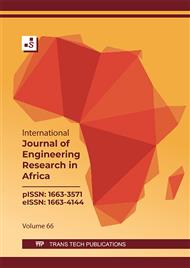[1]
G. Heerten, Reduction of climate-damaging gases in geotechnical engineering practice using geosynthetics, Elsevier, Geotextiles and Geomembranes, 30 (2012) 43-49.
DOI: 10.1016/j.geotexmem.2011.01.006
Google Scholar
[2]
A. Petek Gursel, E. Masanet, A. Horvath, A. Stadel, Life-cycle inventory analysis of concrete production: A critical review, Cem. Concr. Compos. 51 (2014) 38–48.
DOI: 10.1016/j.cemconcomp.2014.03.005
Google Scholar
[3]
M.E. Boesch, S. Hellweg, Identifying Improvement Potentials in Cement Production with Life Cycle Assessment, Environ. Sci. Technol. 44 (2010) 9143–9149.
DOI: 10.1021/es100771k
Google Scholar
[4]
F. Collins, Inclusion of carbonation during the life cycle of built and recycled concrete: influence on their carbon footprint, Int. J. Life Cycle Assess. 15 (2010) 549–556.
DOI: 10.1007/s11367-010-0191-4
Google Scholar
[5]
E. Wang, Z. Shen, A hybrid Data Quality Indicator and statistical method for improving uncertainty analysis in LCA of complex system – application to the whole-building embodied energy analysis, J. Clean. Prod. 43 (2013) 166–173.
DOI: 10.1016/j.jclepro.2012.12.010
Google Scholar
[6]
N. Yusof, N.Z. Abidin, S.H.M. Zailani, K. Govindan, M. Iranmanesh, Linking the environmental practice of construction firms and the environmental behaviour of practitioners in construction projects, J. Clean. Prod. 121 (2016) 64–71.
DOI: 10.1016/j.jclepro.2016.01.090
Google Scholar
[7]
V. Yepes, J.V. Martí, T. García-Segura, Cost and CO2 emission optimization of precast–prestressed concrete U-beam road bridges by a hybrid glowworm swarm algorithm, Autom. Constr. 49 (2015) 123–134.
DOI: 10.1016/j.autcon.2014.10.013
Google Scholar
[8]
M. Jayakeerti, G. Nakkeeran, M. Durai Aravindh, L. Krishnaraj, Predicting an energy use intensity and cost of residential energy-efficient buildings using various parameters: ANN analysis, Asian Journal of Civil Engineering, 47 (2023).
DOI: 10.1007/s42107-023-00717-y
Google Scholar
[9]
G. Nakkeeran, L. Krishnaraj, Optimization and performance analysis of residential building for sustainable energy design through BIM, Journal of Engineering Research, 9 (2022).
Google Scholar
[10]
C.K Anand, B. Amor, Recent developments, future challenges and new research directions in LCA of buildings: a critical review, Renew. Sustain. Energy, 67 (2017) 408–416.
DOI: 10.1016/j.rser.2016.09.058
Google Scholar
[11]
K.F. Bizjak, S. Lenart, Life cycle assessment of a geosynthetic-reinforced soil bridge system – A case study, Elsevier, Geotextiles and Geomembranes, 46 (2018) 543–558.
DOI: 10.1016/j.geotexmem.2018.04.012
Google Scholar
[12]
W. Taktak, A. Loulizi, Selection of a pavement structure from technically established alternatives based on construction cost, energy consumption, and carbon footprint, International Journal of Engineering Research in Africa, 62 (2022) 85-106.
DOI: 10.4028/p-xx05a5
Google Scholar
[13]
I.P. Damians, R.J. Bathurst, E.G. Adroguer, A. Josa, A. Lloret, Sustainability assessment of earth-retaining wall structures, Environ. Geotech. jenge. 16.00004 (2016).
DOI: 10.1680/jenge.16.00004
Google Scholar
[14]
P. Zastrow, F. Molina-Moreno, T. García-Segura, J.V. Martí, V. Yepes, Life cycle assessment of cost-optimized buttress earth-retaining walls: A parametric study, J. Clean. Prod. 140 (2017) 1037–1048.
DOI: 10.1016/j.jclepro.2016.10.085
Google Scholar
[15]
J.J. Pons, V. Penadés-Plà, V. Yepes , J.V. Martí, Life cycle assessment of earth-retaining walls: an environmental comparison, J. Clean. Prod. 192 (2018) 411–420.
DOI: 10.1016/j.jclepro.2018.04.268
Google Scholar
[16]
F. Molina-Moreno, J.V. Martí, V. Yepes, Carbon embodied optimization for buttressed earth-retaining walls: Implications for low-carbon conceptual designs, J. Clean. Prod. 164 (2017) 872–884.
DOI: 10.1016/j.jclepro.2017.06.246
Google Scholar
[17]
R.K. Giri, K.R. Reddy, Sustainability assessment of two alternate earth-retaining structures, Geotech. Spec. Publ. GSP, 256 (2015) 2836–2845.
DOI: 10.1061/9780784479087.265
Google Scholar
[18]
R. Frischknecht, S. Büsser-Knöpfel, R. Itten, M. Stucki, H. Wallbaum, Comparative life cycle assessment of geosynthetics versus concrete retaining wall, 18th. Int. Conf. Soil Mech. Geotech. Eng. Challenges, Innov. Geotech., ICSMGE 2013, 3 (2013) 1979–1982.
Google Scholar
[19]
A. Colas, D. Garnier, G. Habert, Y. Tardivel, Advances on structural, environmental and economical analysis of dry-stone retaining walls, SAHC2014 - 9th International Conference on Structural Analysis of Historical Constructions, (2014) 14–17.
Google Scholar
[20]
A.T. Balasbaneh, D. Yeoh, M.I. Juki, M.H.W. Ibrahim, A.R. Zainal Abidin, Assessing the life cycle study of alternative earth-retaining walls from an environmental and economic viewpoint, Environmental Science and Pollution Research, 28 (2021) 37387–37399.
DOI: 10.1007/s11356-021-13190-4
Google Scholar
[21]
EN ISO 14040, Environmental Management, Life Cycle Assessment, Principles and Framework, 2006.
Google Scholar
[22]
EN ISO 14044, Environmental Management, Life Cycle Assessment, Requirements and Guidelines, 2006.
Google Scholar
[23]
J. Hong, G.Q. Shen, Y. Peng, Y. Feng, C. Mao, Uncertainty analysis for measuring greenhouse gas emissions in the building construction phase: a case study in China, J. Clean. Prod. 129 (2016) 183–195.
DOI: 10.1016/j.jclepro.2016.04.085
Google Scholar
[24]
S. Nocera, O. I. Galati, F. Cavallaro, On the uncertainty in the economic valuation of carbon emissions from transport, Journal of Transport Economics and Policy, 52 (2018).
Google Scholar
[25]
International Bank for Reconstruction and Development, the World Bank, Carbon Pricing Leadership Coalition, Carbon Pricing Leadership Report, Washington DC, 2020.
Google Scholar
[26]
M.N. Hassoun, A. Al-Manaseer, Structural concrete: theory and design, Hoboken, Wiley, 6 (2015).
Google Scholar
[27]
M. Zermani, K. Belaid, R. Harzaz, P. Gendrin, Aménagement et soutènements avec massif renforcé par géootextile avec retour au parement et parement Atalus, 10ème rencontres Géosynthétiques, La rochelle, France, Mars 2015.
Google Scholar
[28]
Fine, GEO5 – Geotechnical Engineering Software, Fine – Civil Engineering Software, France. See http://www.finesoftware.fr (accessed 16/01/2023).
Google Scholar
[29]
Béton armé aux états limites, BAEL 91, Règles techniques de conception et de calcul des ouvrages et constructions en béton armé suivant la méthode des états limites, 1991.
DOI: 10.51257/a-v1-c2317
Google Scholar
[30]
Ecoinvent Center, 2016, Ecoinvent v3.3, http://www.ecoinvent.org/database/older-versions/ecoinvent-33/ecoinvent-33.html (accessed 30/01/2023).
DOI: 10.4018/978-1-59140-342-5.ch003
Google Scholar
[31]
J.P. González, G.G. Gosálbez, J.M.M. Sanz, L.J. Jiménez, Statistical analysis of the ecoinvent database to uncover relationships between life cycle impact assessment metrics, J. Clean. Prod., 112 (2016) 359–368.
DOI: 10.1016/j.jclepro.2015.05.129
Google Scholar


